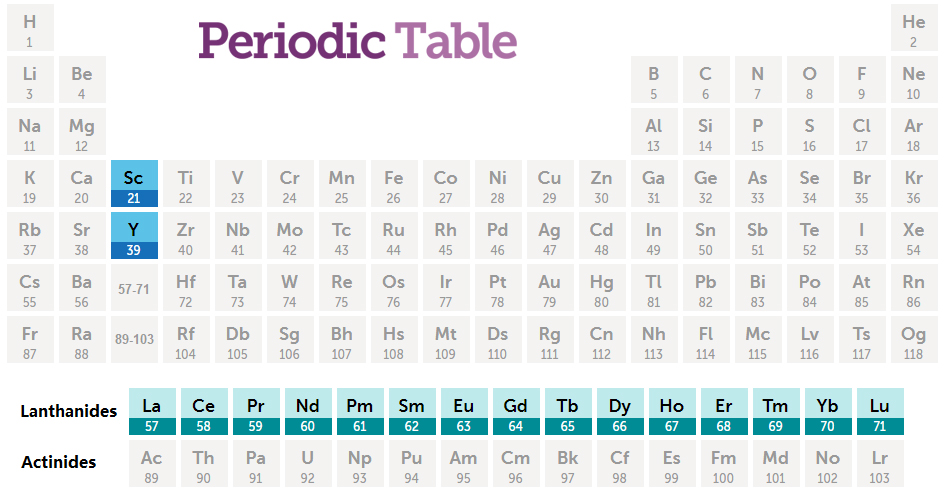What are permanent magnets made of?
Modern permanent magnets are made of special alloys to create better and better magnetic characteristics. The most common magnet materials today are ones made out of Aluminum-Nickel-Cobalt (AlNiCo Magnets), Strontium-Iron (Ferrite Magnets, also known as Ceramic Magnets), Neodymium-Iron-Boron (Neodymium magnets or briefly called Neo magnets), and Samarium-Cobalt (SmCo magnets). The Samarium-Cobalt Magnets and Neodymium-Iron-Boron Magnets are collectively known as the Rare Earth Magnets.
What are rare earth magnets?
Rare earth magnets are made out of the rare earth elements including lanthanides and another two elements with similar characters: Sc and Y. (Totally 17 elements. See the periodic table of elements below). The most common rare earth magnets are Neodymium-Iron-Boron magnets and Samarium Cobalt magnets.

Will permanent magnets lose their power over time?
Permanent magnets do lose a very small fraction of their magnetism over time, but it can almost be ignored. For example, Samarium cobalt magnets have been shown to be less than 1% loss over a period of ten years, but please store the magnets away from external strong magnetic fields (beside power lines, close to other strong magnets), radiation and high temperatures.
What is the difference between SmCo5 and Sm2Co17?
- For the grade we use YX to represent SmCo5 and YXG represent Sm2Co17.
- Different components: the main components of SmCo5 are samarium, cobalt, praseodymium or just samarium and cobalt while for Sm2Co17 they are samarium, cobalt, copper, iron and zirconium.
- Different physical characteristics: such as the maximum working temperature for SmCo5 is 250 ℃ while it can be 350 ℃ at maximum for Sm2Co17. SmCo5 is much easier for machining compared to Sm2Co17, which is more brittle.
- Physical properties comparison (SmCo5 Vs Sm2Co17)
| Grade | SmCo5 (RECo5) | Sm2Co17 (RE2Co17) |
|---|---|---|
| Density | 8.2-8.4g/cm³ | 8.3-8.5g/cm³ |
| Curie Temperature | 750℃ | 800℃ |
| Max. Working Temp. | 250℃ | 300-350℃ |
| Temp. Coefficient of Br T.C.α (Br) |
-0.05%/℃ | -0.03%/℃ |
| Temp. Coefficient of Hcj T.C.β (Hcj) |
-0.3%/℃ | -0.2%/℃ |
| Recoil Permeability | 1.00-1.05 | 1.00-1.10 |
| Electrical Resistivity | 5~6×10-5Ω.cm | 8~9×10-5Ω.cm |
| Vickers Hardness | 450-500Hv | 500-600Hv |
| Thermal Conductivity | 12 | |
| Thermal Expansion Coefficient (Perpendicular to Magnetization Direction) |
13×10-6/℃ | 11×10-6/℃ |
| Thermal Expansion Coefficient (Parallel to Magnetization Direction) |
6×10-6/℃ | 8×10-6/℃ |
| Compressive Strength | 420~680 Mpa | 700~830 MPa |
How can I estimate the magnet pull force and flux density in the design phase?
You can use our Magnets Calculator Tool to get the approximate pull force and magnetic flux density for block/bar, disc and ring magnets.
Notes:
Pull force is one of the measuring methods to rate the strength of a magnet. It is typically defined as the force to separate the magnet from a low carbon steel plate for a direct touch and direct pull condition. The steel plate should be thick enough to contain all the magnetic field lines. Normally we use 20 mm ( 0.787″ ) thick but it is still based on how thick the magnet is. The steel plate surface should be smooth, clean and without any painting. The force to pull off the magnet should be perpendicular to the surface.
What information should I provide in my inquiry?
- Maxmium working temperature.
- Magnet’s grade or magnetic flux density on the center.
- Magnet dimensions and tolerance.
- Any surface treatment on the magnet?
- Order quantity.
- Any special requirements for the packaging and transportation?
- What is your standard inspection method for the magnet?
- If possible, we had better know the magnet application: such as the speakers, motors, separators, pot magnets and sensors, etc.
How about the payment terms?
We accept T/T, Western Union and Paypal.
